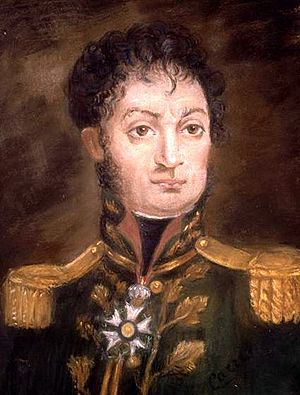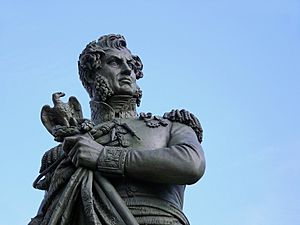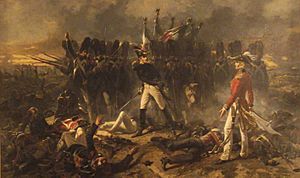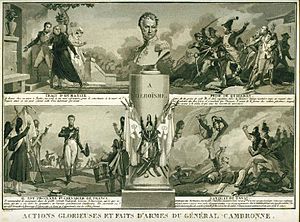Pierre Cambronne facts for kids
Quick facts for kids
Pierre Jacques Étienne Cambronne
Viscount Cambronne
|
|
|---|---|

Portrait of Cambronne, 1815
|
|
| Born | 26 December 1770 Nantes, France |
| Died | 29 January 1842 (aged 71) Nantes, France |
| Allegiance | French First Republic First French Empire Kingdom of France |
| Service/ |
French Army |
| Years of service | 1792–1823 |
| Rank | Brigadier General |
| Battles/wars | French Revolutionary Wars Napoleonic Wars |
| Awards | |
Pierre Jacques Étienne Cambronne (born December 26, 1770 – died January 29, 1842) was a brave French general. He fought in many important wars, like the French Revolutionary Wars and the Napoleonic Wars. He is famous for his courage, especially during the Battle of Waterloo.
Contents
Early Life and Military Start
Cambronne was born in a small town near Nantes, France. In 1792, when he was 21, he joined the army as a volunteer. He became a Grenadier, a type of soldier known for their strength and bravery.
He fought in many battles across Europe. These included campaigns in Belgium and the Vendée region of France. He also took part in a battle at Quiberon and an expedition to Ireland.
Rising Through the Ranks
Cambronne joined the Army of the Alps in 1799. There, he showed great skill and was promoted. He became the leader of a grenadier company at the Second Battle of Zürich.
In 1800, he became famous for his bravery. He was even called the "First Grenadier of France." In 1806, he became a Colonel after the Battle of Jena-Auerstedt. Later, he was put in charge of a special unit called the 3rd Regiment of the Voltigeurs of the Guard. Voltigeur means "leaper" in French. These were elite light infantry soldiers.
Cambronne continued to fight for France. He served in Spain and then joined La Grande Armée, Napoleon's main army. He fought in major battles in Russia, including Bautzen, Dresden, and Leipzig. After these battles, he was promoted to General.
The Hundred Days and Waterloo
In 1814, Cambronne became a major in the Imperial Guard. He went with Napoleon when he was sent away to the island of Elba. Cambronne was a military leader there.
When Napoleon escaped Elba and returned to France in 1815, Cambronne was with him. This period is known as the Hundred Days. Cambronne helped Napoleon capture the fortress of Sisteron. When they reached Paris, Napoleon made Cambronne a Count.
Cambronne fought bravely at the Battle of Waterloo. He was seriously wounded and was taken prisoner by the British. After the battle, he married the nurse who took care of him.
The Famous Reply at Waterloo
Cambronne is very famous for what he supposedly said at the end of the Battle of Waterloo. He was leading the last group of Napoleon's elite soldiers, the Old Guard. A British general asked him to surrender.
One story says Cambronne replied: "La garde meurt mais ne se rend pas!" This means "The Guard dies but does not surrender!" These words became very famous and are even on a statue of Cambronne in Nantes.
Another story says he gave a very strong, one-word reply. Cambronne himself always said he couldn't have said either of these things and still be alive. Some letters written at the time claimed a British Colonel named Hugh Halkett captured Cambronne before he could say anything. The exact words remain a mystery, but they show his legendary courage.
Later Life and Legacy

After the war, Cambronne was put on trial in France. However, he was found not guilty in 1816. He then married Mary Osburn, the Scottish nurse who had helped him after Waterloo.
In 1820, the French king, Louis XVIII, made him a viscount and gave him a command in Lille. Cambronne retired in 1823 and returned to his hometown. He passed away there in 1842.
Today, a statue of Cambronne stands in Nantes. There is also a square in Paris called Place Cambronne that remembers him.
He was buried in Cemetery Miséricorde, Nantes.
See also
 In Spanish: Pierre Cambronne para niños
In Spanish: Pierre Cambronne para niños



